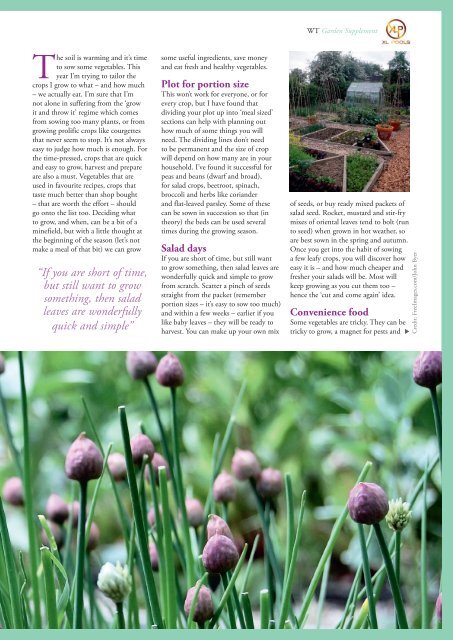Wealden Times | WT182 | April 2017 | Gardens supplement inside
Wealden Times - The lifestyle magazine for the Weald
Wealden Times - The lifestyle magazine for the Weald
Create successful ePaper yourself
Turn your PDF publications into a flip-book with our unique Google optimized e-Paper software.
WT Garden Supplement<br />
The soil is warming and it’s time<br />
to sow some vegetables. This<br />
year I’m trying to tailor the<br />
crops I grow to what – and how much<br />
– we actually eat. I’m sure that I’m<br />
not alone in suffering from the ‘grow<br />
it and throw it’ regime which comes<br />
from sowing too many plants, or from<br />
growing prolific crops like courgettes<br />
that never seem to stop. It’s not always<br />
easy to judge how much is enough. For<br />
the time-pressed, crops that are quick<br />
and easy to grow, harvest and prepare<br />
are also a must. Vegetables that are<br />
used in favourite recipes, crops that<br />
taste much better than shop bought<br />
– that are worth the effort – should<br />
go onto the list too. Deciding what<br />
to grow, and when, can be a bit of a<br />
minefield, but with a little thought at<br />
the beginning of the season (let’s not<br />
make a meal of that bit) we can grow<br />
“If you are short of time,<br />
but still want to grow<br />
something, then salad<br />
leaves are wonderfully<br />
quick and simple”<br />
some useful ingredients, save money<br />
and eat fresh and healthy vegetables.<br />
Plot for portion size<br />
This won’t work for everyone, or for<br />
every crop, but I have found that<br />
dividing your plot up into ‘meal sized’<br />
sections can help with planning out<br />
how much of some things you will<br />
need. The dividing lines don’t need<br />
to be permanent and the size of crop<br />
will depend on how many are in your<br />
household. I’ve found it successful for<br />
peas and beans (dwarf and broad),<br />
for salad crops, beetroot, spinach,<br />
broccoli and herbs like coriander<br />
and flat-leaved parsley. Some of these<br />
can be sown in succession so that (in<br />
theory) the beds can be used several<br />
times during the growing season.<br />
Salad days<br />
If you are short of time, but still want<br />
to grow something, then salad leaves are<br />
wonderfully quick and simple to grow<br />
from scratch. Scatter a pinch of seeds<br />
straight from the packet (remember<br />
portion sizes – it’s easy to sow too much)<br />
and within a few weeks – earlier if you<br />
like baby leaves – they will be ready to<br />
harvest. You can make up your own mix<br />
of seeds, or buy ready mixed packets of<br />
salad seed. Rocket, mustard and stir-fry<br />
mixes of oriental leaves tend to bolt (run<br />
to seed) when grown in hot weather, so<br />
are best sown in the spring and autumn.<br />
Once you get into the habit of sowing<br />
a few leafy crops, you will discover how<br />
easy it is – and how much cheaper and<br />
fresher your salads will be. Most will<br />
keep growing as you cut them too –<br />
hence the ‘cut and come again’ idea.<br />
Convenience food<br />
Some vegetables are tricky. They can be<br />
tricky to grow, a magnet for pests and <br />
Credit: FreeImages.com/John Byer<br />
7 wealdentimes.co.uk


















